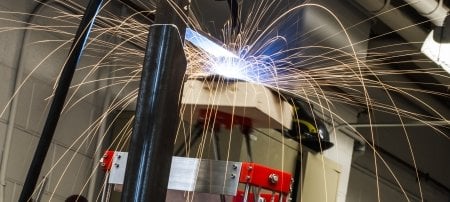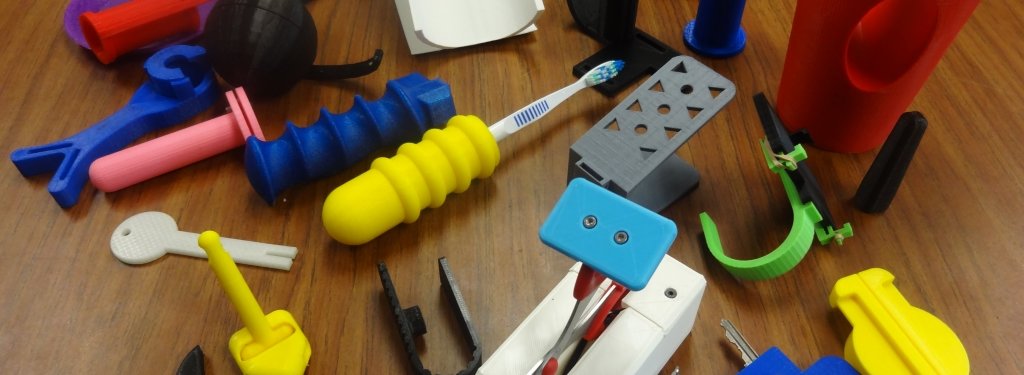3D Printers' Could Change our Economy and our Lives
“When you produce something yourself instead of purchasing it, that changes your relationship to it,” says Chelsea Schelly, assistant professor of social sciences. She’s discussing the current popular trend of 3D printing. “You are empowered by it.”
That principle might sound simple, but its ramifications can be wide ranging, especially for middle and high school educators. That’s where Schelly’s research began: studying a teacher workshop coordinated by 3D printing guru Joshua Pearce, an associate professor of materials science and engineering and electrical and computer engineering.
During the workshop, one of the local high school teachers produced a valuable part and a teachable moment at the same time.
“He needed a snowblower part that would normally cost $200,” Schelly says. “Instead, he made it himself and saved the money.” And he saved the hassle of bringing the machine to the shop to get it fixed.”
And his students in the snow-laden school district clearly got the relevance of that example.
They routinely beg to stay after school to make their own creations on the printer.
“The early feedback from the teachers is that the students are more engaged,” she says. “They take pride in making these things for themselves. This could be seen as part of the larger ‘maker’s movement,’ where people are doing their own production processes.”
Creating and using solar panels on houses, which Schelly also studies, are another example.
“It can be socially transformative,” she says. It can also have some negative consequences, at least initially, she adds.
“This can affect manufacturing jobs and potentially put people out of work,” Schelly says. “Although the low-wage and low-skill work could be affected, like those products produced in China, other positive changes might occur.”
Pearce agrees.
He sees prices coming down as more people print their own products, especially as the price of the printers comes down.
“As 3D printing was open-sourced, the costs plummeted from tens of thousands of dollars to $1,600 for assembled printers today, and the new RepRap printers are down to $500 in parts,” he points out. “As the price drop continues, they will become household items, like desktop printers.”
And, since you can print additional printers, that day might be sooner than originally thought.
“This has the potential to disrupt the way we manufacture,” Pearce says.
He has several examples in his office. One was a centrifuge created to work with an electric drill; another was a component for solar panels.
“The number of designs is exploding,” Pearce says. Users have tried them, proved they work, and with open-source, they pass on the directions, enabling the technology to evolve much faster than normal. “There are a lot of helpers out there,” he explains. “Give us what you’ve got, and we’ll build on it and give you what we’ve got—and we all benefit.”
This new market system is even more prevalent overseas. In Shanzhai open-source hardware is the rule, not the exception.
“An open-source Chinese smartphone was posted online for $130, and 100,000 sold in 90 seconds,” Pearce says.
Schelly is also focused on possible economic policy changes, such as the lowering of the full-time workweek from 40 hours to 30, which might be another offshoot of this type of enterprise. The free time could then be used for more self-sufficiency efforts, and more people could be employed, if fewer work hours are the norm.
“It also is a reflection of what we want people engaged in: something other than mindless, menial tasks,” she says. “It could mean getting the imports from China out of the cycle. Printers could be organized in the US at the community scale.”
It requires a new attitude, but she was surprised at how quickly those teachers changed their mind-sets.
“In just three days, they could see the environmental value,” Schelly says. “They were empowered, and the fact that they made this, and their students will make more, means that the students will be inspired, too, instead of passively consuming.”
Thanks to the ability of printers to replicate themselves, Schelly can foresee the day when those high school teachers run their own workshops.
“There are open source, visual, online instructions,” she says. “If any teacher can do it, so what happens now?”
It’s a question she’ll be examining as she continues her research, and Pearce continues to pursue printing just about anything.
Michigan Technological University is an R1 public research university founded in 1885 in Houghton, and is home to nearly 7,500 students from more than 60 countries around the world. Consistently ranked among the best universities in the country for return on investment, Michigan's flagship technological university offers more than 185 undergraduate and graduate degree programs in science and technology, engineering, computing, forestry, business, health professions, humanities, mathematics, social sciences, and the arts. The rural campus is situated just miles from Lake Superior in Michigan's Upper Peninsula, offering year-round opportunities for outdoor adventure.




Comments